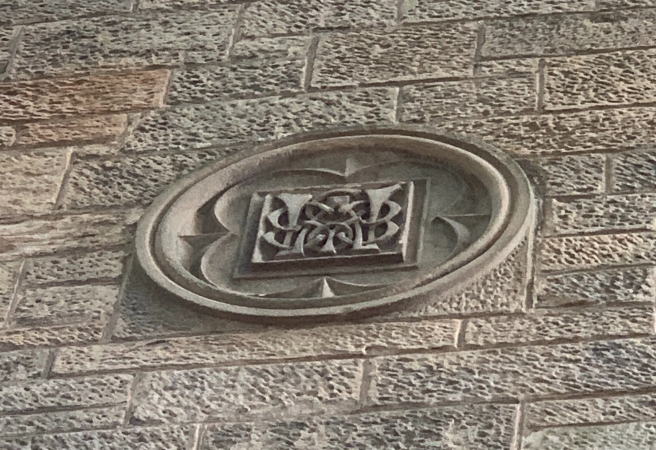“That a town like Greenock should be without a system of baths such as to be found in other populous localities has often been a matter of surprise.”

That declaration accompanied the public announcement of the formation of the Greenock West-End Baths Company in the Greenock Telegraph & Clyde Shipping Gazette of September 1879.
The Company was created by a group of eminent Greenockians to erect a swimming pool and Turkish baths in Greenock’s west end after the model of the Arlington Baths in Glasgow. The company issued shares and formed a provisional management committee, like the Glasgow Swimming Baths Company nine years previously.
The West End Baths was designed by Mr Henry Higgins of Bucher & Higgins, Glasgow, and constructed between January 1880 and April 1881. It sat on Campbell Street near Princes Pier. Opened on 25th April 1881 by Sheriff Smith, construction cost between £5000 and £6000.

The building
The building had four floors. The main entrance on Campbell Street led to the entrance foyer with the Bathsmaster’s office and swimming essentials storage on the left. A system of pneumatic bells linked every part of the building to the Bathsmaster’s office. On the right was the well-lit reading room with windows to Campbell Street and Houston Street.
Ahead from the foyer was the shoe hall and the sea water swimming pond. It measured 80 ft by 35 ft and ranged in depth from 3 ft 5 inches to 6 ft 10 inches. It was lined with white tiles with red border tiles. Four sets of marble steps led into the pond and a diving platform allowed diving from 10ft in height.
Either side of the pond were two stands of dressing boxes with maroon curtains, and a viewing gallery.

The rest of the ground floor contained private baths and a Turkish bath. The Turkish bath had four rooms:
- Dressing room with cathedral style window.
- Tiled Tepidarium with a domed roof, fountain and cruse oil lamps.
- Dome-roofed Caldiarium with alternate bands of marble and tiles on the walls.
- Tiled Lavatorium fitted with spray, douche, wave and vapour baths.
The Turkish was heated by a pair of convoluted Gill stoves, which were also in use at the Arlington Baths.
On the first floor were the smoking and billiard rooms, containing two billiard tables. The top floor was accommodation for the Bathsmaster.
The basement held the laundry, boiler and other plant. The Bath’s ventilation system was similar to the plenum system used in the Arlington Baths; a series of zinc-lined shafts connect from ventilators on the roof to the boiler room using the updraft from the boiler to circulate air around the building.
Building contractors:
- Mason and brick work: Hugh Steel
- Joiner: Smith & McCuaig
- Plasterer: Hugh Tannock
- Plumber: Wm Adam & Co
- Slater: Peter McKay
- Ironfounding: Crawford & Thomson
- Tiling: John Findlay
- Glazier: James Graham
- Gas Fitting and Pneumatic bell system: H McP, Watson
- Heating and Ventilation: John Hay of Glasgow
Community and membership

The club opened with between 400-500 members and membership cost 42 shillings for Town, 31 shillings for Country and 21 shilling for Ladies.
The West-End Baths held many swimming competitions and galas, like the other swimming clubs of the time, including ‘Aquatic Entertainment in costume’ and displays of ‘Ornamental and Trick Swimming’.
The Baths was also home to Greenock Amateur Swimming Association and West End Whist Club.
Closure and the Greenock Arts Guild
The Baths club closed in 1941 and was bought by the Greenock Arts Guild in 1946. The Arts Guild opened the building in 1949 as a theatre using two meeting rooms and the old billiard room as a 100-seater auditorium named after Wallace Bennett, a local RAF serviceman.
The Arts Guild then undertook more extensive renovations and by 1955 the main auditorium was formed from the swimming pond itself, using the slope of the pool as raked seating for 450 people with the stage at the deep end.

The Arts Guild occupied the building until 2012; the final show was a performance of Cinderella on 8 December 2012. The Arts Guild then moved to the purpose built Beacon Arts Centre on the river front in January 2013.
The former Baths building then fell into disrepair and suffered a series of deliberate fires in late 2020 which led to it being declared unsafe. The building was finally demolished in February 2021 and the land cleared for potential house building.
Researcher: Will Jess
Also see this tweet by Malcom Shifrin, author of Victorian Turkish Baths:
Sources
- Dictionary of Scottish Architects – Swimming Pool and Turkish Bath
- Dundee Evening Telegraph, 25 August 1879
- Greenock Westend Baths, Greenock Telegraph & Clyde Shipping Gazette, 25 April 1881
- Huge Fire at Greenock Arts Guild Building, Greenock Telegraph, 15 November 2020
- Stage Set for Greenock Arts Guild Final Curtain, Greenock Telegraph, 11 February 2021

One thought on ““Baths on a somewhat extensive scale”… The West-End Baths, Greenock”